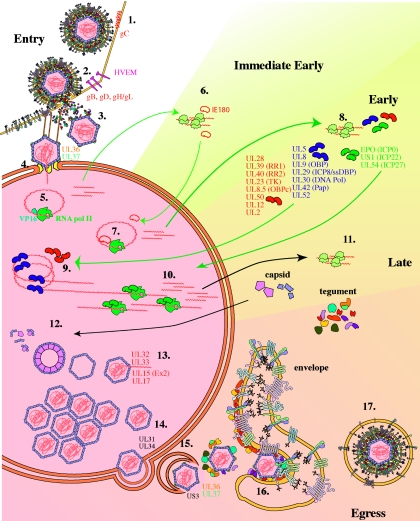FIG. 3.
Replication cycle of PRV. 1. Entry begins with attachment or binding of the virus particle to the cell surface. In PRV, this initial binding step is an interaction between gC in the virion envelope and heparan sulfate on the surface of the cell. 2. The next steps of entry require gD, gB, gH, and gL. In PRV, although gD is not essential for membrane fusion or cell-cell spread, gD interacts with the cellular herpesvirus entry mediator (HVEM) and is required for entry of extracellular virus (penetration). 3. After fusion of the virion envelope with the cell membrane, the capsid and tegument proteins are released into the cell. The viral tegument proteins begin takeover of the host cell protein synthesis machinery immediately after entering the cell. 4. The capsid and tightly bound inner tegument proteins are transported along microtubules to the cell nucleus. 5. The VP16 tegument protein localizes to the nucleus independent of the capsid and transactivates cellular RNA polymerase II transcription of the only immediate-early protein of PRV, the HSV ICP4 homolog IE180. 6. IE180 protein expressed in the cytoplasm is transported back to the nucleus. 7. There, it transactivates RNA polymerase II transcription of the early genes. 8. Early proteins fall into two main categories. The first category comprises 15 proteins involved in viral DNA synthesis. 9. Seven of these proteins (UL5, UL8, UL9/OBP, UL29/ssDNABP, UL30/DNA Pol, UL42/Pap, and UL52) (shown in blue) are essential for replication of the viral DNA. DNA replication occurs by a rolling-circle mechanism. 10. The second category comprises three proteins thought to act as transactivators of transcription (EP0, US1, and UL54). 11. Onset of DNA synthesis signals the start of the late stage of the PRV replication cycle and synthesis of true late proteins. 12. The capsid proteins are transported to the nucleus, where they assemble around a scaffold composed of the product of the UL26 and UL26.5 genes. 13. The mature capsid is composed of five proteins (UL19/VP5, UL18/VP23, UL25, UL38, and UL35). The product of the UL6 gene acts as a portal for insertion of the genomic DNAinto the capsid. UL32, UL33, UL15 (Ex2), and UL17 are all involved in cleavage and packaging of the viral DNA. 14. During primary envelopment, the fully assembled nucleocapsid buds out of the nucleus, temporarily entering the perinuclear space. This process involves the products of the UL31 and UL34 genes along with the US3 kinase. 15 and 16. The nucleocapsid (15) loses its primary envelope and (16) gains its final envelope by associating with tegument and envelope proteins and budding into the trans-Golgi apparatus. 17. The mature virus is brought to the cell surface within a sorting compartment/vesicle derived from the envelopment compartment.

